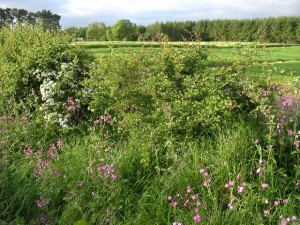05
Nov
Research Finds Hedgerows Reduce Pesticide Use and Promote Biodiversity
(Beyond Pesticides, November 05, 2015) Research at the University of California, Davis finds that hedgerows, a line of shrubs and trees that form a boundary at the edges of farm fields, improve a farm’s ecology and reduce the need for pesticides. Hedgerows serve many other beneficial functions; they can provide ornamental and aesthetic value, sequester carbon, and be a source of food, and more. There is also evidence that they can be an effective barrier against spray drift, reduce soil erosion, and act as habitat corridors for forest plants in agricultural landscapes. Hedgerows support biodiversity in the face of habitat decline, given fence row to fence row cultivation practices in agriculture, manicured lawns and landscapes, urban sprawl, and the use of broad spectrum pesticides that threaten the diverse organisms that make up a healthy ecosystem.
 Rachael Long, M.S., a farm advisor for the UC Cooperative Extension, tells Capital Public Radio, “We have Christmas berries, and elderberry — which has these beautiful blueberries that a lot of birds really like. We have redbud which has terrifically bright red flowers in the spring. And also ceanothus which is California lilac which has blue flowers in the spring.” She adds that birds and bees feast on the flowering plants’ nectar and pollen. The bushes also provide habitat for natural enemies. “Your lady beetles, and big eyed bugs, as well as green laced wings and little parasitic wasps.” The insects eat the pests that chew on tomato plants.
Rachael Long, M.S., a farm advisor for the UC Cooperative Extension, tells Capital Public Radio, “We have Christmas berries, and elderberry — which has these beautiful blueberries that a lot of birds really like. We have redbud which has terrifically bright red flowers in the spring. And also ceanothus which is California lilac which has blue flowers in the spring.” She adds that birds and bees feast on the flowering plants’ nectar and pollen. The bushes also provide habitat for natural enemies. “Your lady beetles, and big eyed bugs, as well as green laced wings and little parasitic wasps.” The insects eat the pests that chew on tomato plants.
And, if a farmer does spray, hedgerows can prevent water pollution. Long explains, “If they’re planted along some of the drainage ditches then they can really help with trapping sediments and pesticides and also nitrates so they keep those water pollutants away from our streams, rivers and groundwater.” Long’s research concludes that farmers who dedicate some land to hedgerows tend to use fewer chemicals.
With severe loss in recent years of pollinators, including bees, butterflies, and birds, natural and diverse hedgerows take on a new importance in nurturing and restoring populations in decline. They can provide nectar and pollen over the course of an entire growing season, serving as a food source for honey bees as well as parasitoids and other predaceous arthropods that are natural enemies to “pests” like caterpillars. Hedgerows can also provide food such as nuts and berries for insectivorous birds when the insect supply is low, as well as nesting and roosting sites for hawks and owls, whose rodent prey are a perennial concern for farmers.
Of course, hedgerows alone will not counterbalance the widespread use of synthetic pesticides, but they can be a critical tool in slowing pollinator decline and creating zones of protection until land managers (agricultural and nonagricultural) make the shift to sustainable practices that protect biodiversity. Beyond Pesticides supports organic agriculture as affecting good land stewardship and a reduction in hazardous chemical exposures. The pesticide reform movement, citing pesticide problems associated with chemical agriculture, from groundwater contamination and runoff to drift, views organic as the solution to a serious public health and environmental threat. To attract beneficial insects like monarchs and protect their habitats in your own backyard, there are several steps you can take. Like any other living organism, pollinators need food, water, and shelter in order to thrive. For more information, see Managing Landscapes with Pollinators in Mind and Hedgerows for Biodiversity: Habitat is needed to protect pollinators, other beneficial organisms, and healthy ecosystems. You can also visit the BEE Protective Habitat Guide and Do-It-Yourself Biodiversity for more ways in which you can protect monarchs and other pollinators.
All unattributed positions and opinions in this piece are those of Beyond Pesticides.
Source: Capital Public Radio











hedge rows a sanctuary for wild flowers which sustain bees and butterflies and birds,offer shelter to birds,bees,butterflies ,small mammals ad reptiles mice,mangoose,snakes,lizards,terrestial snails – they are a self contained ecosystem by them selves drawing sustanence partly from the harmfull insects of bordering cropplants.
they reduce wind and water erosion – improve rain water percolation in to aquifiers..
it should be made mandatory to maintain hedge rows on crop lands- to break the ill effects of mono culture. off course they might hinder the movement of farm machinery ,if rows of hedges criss cross the crop lands. at least the borders of such wast priarie lands should have a broad at least 60 feet border hedges.
this will break the monotony of monoculture and omprove the ecosyste,
the british country side vows its beauty to the hedges without which many species of butterflies would have vanished
k.durga prasad/ retired rice farmer fom india
November 9th, 2015 at 11:20 pm